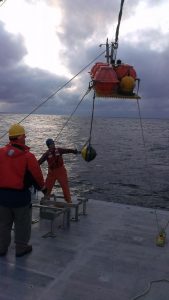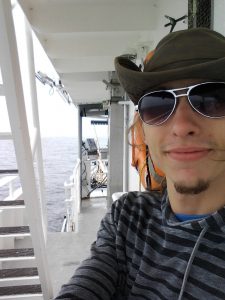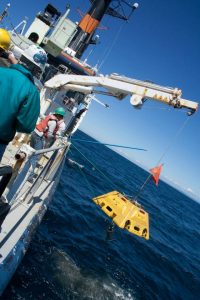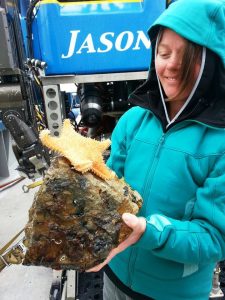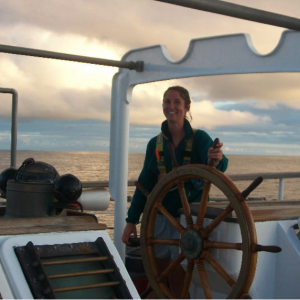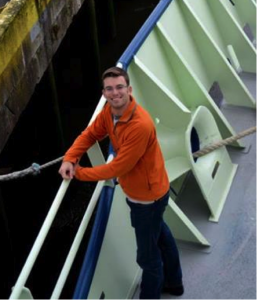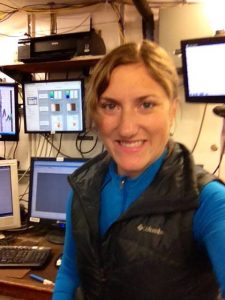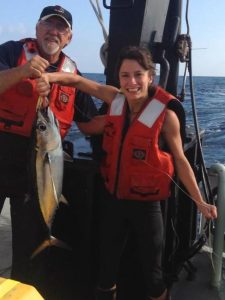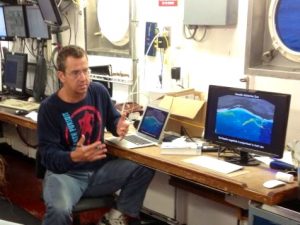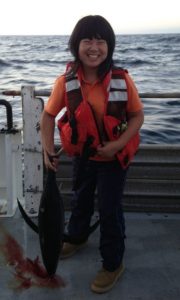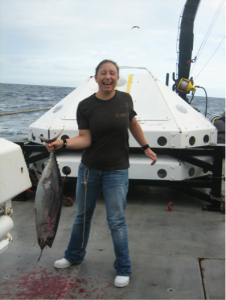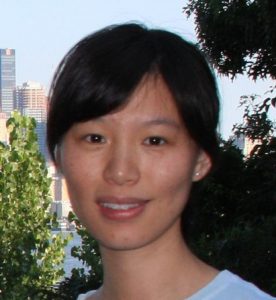Contents
Apply To Sail 2013
Cruise Leg 1: June 3 – June 14, 2013
Sara Kowalke
Graduate Student at University of Minnesota
As a girl from landlocked Minnesota, the opportunity to be at sea on the open ocean is not something that comes by very often. When I discovered the CIET Apply to Sail program I expected some unique field experience, but what I got was a grand adventure. My previous experiences in seismology predominantly took place in front of a computer sifting through data, so this research cruise gave me valuable insight into how oceanic seismic data is obtained. Being on deck while the OBS is being plucked from the ocean, especially knowing it contains raw data from locations once believed to be inaccessible, is pretty amazing. The crew worked together and were synched despite little verbal communication. It was evident that they had retrieved OBS bundles many times before. It certainly gave me new perspectives on the effort required to make ocean seismology possible and I gained more respect for the researchers who develop new techniques to further the field.
Hannah Mejia
Graduate Student at California State Polytechnic University, Pomona
Being interested in subduction zone seismology and the application of geophysics, I decided to participate in the CIET Apply To Sail Program. The experience gave me further insight into using ocean bottom seismometers as a tool to learn more about a subduction zone environment. I went into the experience not knowing what to expect. I had never been on a ship for longer than a few hours, so being on the water for nearly two weeks was going to be an adventure. During those two weeks at sea, I helped retrieve and safely secure a large set of seismometers. Not only did I learn about the mechanics behind ocean bottom seismometer retrievals, but I also learned that I can survive 20+ foot ocean swells and a constantly rocking ship. I also gained an admiration for the people who make their living working as crew on research vessels like the R/V Oceanus. I will continue to look for other opportunities to be involved with ocean bottom seismometers.
Cruise Leg 2: June 17- June 23, 2013
Stanislav Edel
Graduate Student at New Mexico Institute of Mining and Technology
I am a MS student in Geophysics studying induced seismicity in New Mexico. Since I am a transfer student from astrophysics to geophysics, participation in a Cascadia Cruise was a great opportunity to learn something completely new, something I didn’t really know anything about. In fact, the ocean bottom seismometers (OBSs) we recovered aboard the Oceanus were the first seismometers I ever got to see. I had a great time aboard the Oceanus. I met many interesting people and made great new friends. I had no prior experience at sea. The crew and scientists were very rewarding to be around in terms of abundance of available knowledge and pleasantry of interaction. We were fortunate with favorable weather and had a pleasant cruise, completing 15 OBS recoveries in 5 days, 1 day ahead schedule. This cruse was an abundant learning experience and a fun adventure for me. Everyone worked as a team and followed the necessary safety procedures. Along with the seismometers, we recovered some marine life, and it was fantastic to have Bill Hanshumaker, who is a marine education specialist, there to attempt to identify the species and decide what to do with them. Bill gave all of us a fantastic tour of the marine center, located right next to the Oceanus dock. We got to see octopi, fishes, live corrals, anemones you can touch, learning exhibits and much more! It was fun and educational. Participation in the Cascadia Initiative Cruise taught me about ocean seismology, seismometer design and work at sea. It has given me a completely new perspective and appreciation for the ocean and people who sail on it.
Laura Fattaruso
Graduate Student at University of Massachusetts Amherst
Going to school in Massachusetts, people are often surprised when I tell them I study earthquakes. One of the perks, it turns out, is getting to adventure to exotic places (Gorda Ridge, anybody?). Reading about seismological research, it is easy to be impressed with the wealth of information geophysicists extract from some shaking in the ground. Having never done field work in seismology, what stood out most from this cruise was the incredible design and engineering that went into collecting this data. Seeing a team of scientists and engineers coordinating with the crew of a ship, I felt struck by the reality of what science in action looks like, and what can be accomplished through collaboration. I didn’t know what to expect from ship life, but to sum it up concisely: The motion of the ocean stops for no stomach. The motion of the ocean is also soothing, and often sleep-inducing after lunch, so plan accordingly. The ship is well-stocked with books, movies, games, and characters to enjoy them with. The food is very, very good. And there is nothing quite like the crashing of waves against the hull as you watch moonlit clouds float by over a landless skyline.
Cruise Leg 3: June 25 – July 9, 2013
Samantha Bruce
Adjunct Instructor at College of Charleston
The primary objective of Leg 3 of the 2013 CIE was to recover 30 ocean bottom seismometers (OBSs) located off the Oregon and Northern California coasts using acoustic sonar signaling and the ROV Jason. Prior to setting sail I didn’t fully consider the amount of work or the number of teams of people involved in a seismic cruise of this nature. Recovering OBSs is a labor intensive task that requires the skilled execution of a variety of marine field techniques. This takes place in an environment where the ability to work is often determined by the state of the sea, and safety must always be taken into consideration. I learned a lot about the continuous planning, re-planning and troubleshooting that is ongoing throughout an oceanographic research cruise. While working on deck with the Lamont-Doherty Earth Observatory OBS team and the R/V Atlantis crew I was involved first hand with the recovery of the OBSs and also helped prepare the equipment so that it could be packed, shipped and used again. The R/V Atlantis was equipped with a hull-mounted Kongsberg EM122 multibeam system. Therefore during transit between OBS sites and throughout the nights we were able to seize the opportunity to collect swath bathymetry of the seafloor, identify potential methane vents and collect time series water column data of known methane vents. This is the one aspect of the cruise that I had previous experience doing, collecting hydrographic survey data. I still, however, learned a good deal about data acquisition, and especially about the planning and careful thought involved to obtain the best data possible in the most efficient manner. Overall I learned an invaluable amount of information about team work, marine field work and the planning of research cruises. I consider myself very lucky to have participated in the CIE and think the Apply to Sail program is a wonderful and effective way to teach young scientists about the many aspects of an oceanographic cruise, specifically as it relates to seismology.
Katie Kirk
Graduate student at Cornell University & Woods Hole Oceanographic Institute
Sailing on the R/V Atlantis was an amazing opportunity to learn more about ocean seismology and ocean-bottom seismometers (OBS). My Master of Engineering research focused in physical oceanography and bioacoustics, so I had little experience with in situ seismic observations and instrumentation prior to the cruise. I learned a tremendous amount about how the OBS detects movements in the Earth’s crust, the advantages of the different encasing designs (e.g. trawl resistant mounts (TRM), pop-ups & float – ups), and the recovery process for each design structure. I appreciate the folks from Lamont-Doherty Earth Observatory who answered my many questions regarding OBS’s and allowed me to get a hands-on experience helping them break down the TRM’s after recovery. On our cruise, we had the opportunity to hold station over a methane vent and image the temporal variability of methane expulsion using the water column imaging option of the multi-beam swath bathymetric system. Personally, a highlight of the cruise was to be on board during Jason (WHOI’s AUV) deployments and observe the ocean floor at 900+m via the cameras mounted onto Jason. I truly enjoyed my time at sea with the Cascadia Initiative scientists and crew and recommend anyone thinking of applying to sail.
Anton Ypma
Graduate student at Western Washington University
My time on the R/V Atlantis did a great job of showing me first hand that the geology of the sea floor is just as interesting and diverse as the geology on land. One of the most memorable things to me was our use of the bathymetry equipment to scan Hydrate Ridge, which is a formation composed of methane hydrate – a flammable substance that looks like ice. But with the amount of different things that we did in two weeks on a 24 hour schedule, it is difficult to pick just one thing. It is amazing to think that every time we sent the JASON ROV down to collect a seismometer, its cameras were looking at a part of the sea floor that had likely never been looked at before. This really drove home the idea that some things that we take for granted when working on land, such as orientation of the seismometer during installation and the ability to look carefully at the rock and sediment that it is installed on, are much more difficult to achieve when working at sea – it really does present a completely different set of challenges.
Cruise Leg 4: August 1 – August 14, 2013
Miles Bodmer
Graduate Student at University of New Mexico
The experience of working on the Oceanus is one that I will never forget. As a first year graduate student, with all of my undergraduate experience being in physics and mathematics, I was eager to immerse myself in ocean seismography. I wasn’t sure what to expect having never been out to sea, let alone for two weeks. After a few days though, I began to fall into a rhythm and the time aboard seemed to melt by. We broke into two shifts to make sure there was always a science crew ready when an instrument was deployed. Between sites there were small projects to work on, mine being to help analyze OBS data, which was a great learning experience for me. However, the best part was definitely the people. The professors were always quick to lend their advice and expertise in order to make the experience meaningful and manageable. My fellow graduate students came from diverse disciplines and all shared a sense of enthusiasm for the project. The fantastic WHOI team made themselves available to explain the technical details of the OBSs or just to hang out on deck. Additionally, the crew took excellent care of us and provided some of the tastiest meals I’ve ever had. I would absolutely go on another CI cruise and hopefully next time I’ll place better in the corn-hole tournament.
Christina King
Graduate Student at University of Rhode Island
While sailing on the Cascadia Initiative Cruise 1307C I learned a lot more than I thought I would. I had been out on previous cruises that utilized various geophysical techniques including active seismics but I had never been involved in a cruise where OBS were deployed. I was very surprised to learn that the OBS were not lowered to the sea floor and they were just dropped off the side of the ship. I think the most useful thing I learned was how a large project like the Cascadia Initiative, solved major problems. A major roadblock occurred when the first two ARRA OBS lost communication with the ship. It was hard to see what the next move was. Fortunately, the PIs and WHOI technicians kept all the graduate students informed, so we got to hear first hand all the different options for the next step in the experiment and how that evolved very quickly each hour for a couple of days. Obviously, it takes many people at various positions to determine how to problem solve an issue of that magnitude. As a graduate student hoping to stay in academia I found the observation of problem solving a very useful process. Open communication and creative discussion of options clearly played a big role. I consider myself a marine geology who loves to working with data. However, while sailing in between deployment sites, our ship came across a pod of hundreds of Dals porpoises and Northern Right Whale Dolphins and it was hard not to get excited. With the entire crew, all scientists and technicians out on deck it was something to behold. There was just no greater feeling than being in the middle of the Pacific surrounded on all sides by endless ocean, standing on the bow on the ship and watching marine mammals swim along the wake of the ship. It was a day like that that really confirmed my love for the ocean and that I made the right career choice in life.
Ye Tian
Graduate Student at University of Colorado at Boulder
Set sail in the R/V Oceanus at the beautiful sunrise of Newport, Oregon, we started out 11 days trip on Aug 1st 2013 under the lead of Professor Douglas Toomey and Professor William Wilcock. Acquired in the trip was 23 OBS deployments, along with the knowledge we learned and the happy memories we had along the road. It was the first time for me to be at the sea with all the bright sunshine and the endless blue waves and it excited me so much being surrounded by a real world dolphin show in the middle of the ocean or playing corn-hole games while swinging with the ocean. As a geophysics student working with large amount of seismic data, I have been willing to work at sea learning the marine seismic technics for years. The WHOI team and the crews helped me a lot explaining the OBS instruments and the navigating technics. It was even greater that we were able to participating in the deployment process with monitoring the deploy process and surveying for the accurate location of the OBSs. Understanding how the OBS works and experiencing with the locating process made me much more confident in working with the OBS data. I believe that this great experience will serve me well in my future works and the happiness along the trip will always be with me in my memory.
Cruise Leg 5: OC1308A August 18 – August 24, 2013
Kasey Aderhold
Graduate Student at Boston University
It took landing in the middle of the craton in Indiana at the beginning of undergrad to make me realize that I have always wanted to live and work near the ocean. I have spent the last seven years trying to get back. My time on the R/V Oceanus was the first opportunity to spend multiple days at sea, working on a small subset of a large scientific initiative involving a range of institutions. The crew on our leg were fantastic. Constantly poking fun at us scientists, they were both interested in the work we were doing and also how we got here. Full of advice and always making sure we were having a good time at sea. It seemed that every time I rolled out of bed, bleary-eyed and unaware whether it was night or day, something new was happening on deck. Fishing for tuna on hand-lines tied to the back of the boat, watching a pod of orca whales gambol around our boat or playing with a makeshift cornhole set, there was always something new to see. I wasn’t expecting to be taught the most efficient way to fillet a tuna by the captain, Jeff, who came down on deck to visit. Nor did I expect to be apologizing profusely to the chef, Chris, whose knife I accidentally allowed to slide overboard after my successful fillet. With my free time spent wandering around the ship finding new sunny and dry places to nap, I often found myself sitting down to chat with whomever was around. The Scripps guys were great as well, and I overheard them explaining each remarkable mechanism making up their OBS design each time with the same enthusiasm and pride. After a couple of days I was nipping into the galley for a midnight snack or popping up to the bridge with the feeling of being one of the crew, part of the ship, necessary. Though this ship will drop us off and its crew will depart again within the week leaving us to return to our mainland institutions, I am sure this will not be my last voyage.
Robert Anthony
Graduate Student at New Mexico Institute of Mining and Technology
As a PhD student at New Mexico Tech, my research focuses on characterizing and understanding the generation of background seismic “noise.” I am particularly interested in the temporal evolution of the microseism signal, which is generated when oceanic waves interact with the shoreline. Trends in this signal over seasonal-decadal time periods can thus be related to changes in local storm activity and wave state, perhaps arising from quasi-periodic modes of atmospheric oscillation (e.g. ENSO cycles) or climate change.
Since Ocean Bottom Seismometers (OBSs) are deployed on the sea floor, they offer the unique opportunity to record microseism signals at a close proximity to where these signals are generated. Sailing on the R/V Oceanus and deploying OBS sensors was a fantastic opportunity to meet new scientists as well as the engineers who designed these incredible instruments. I am grateful to have been given the task of analyzing the Power Spectral Densities of past deployments, which revealed novel new sources of instrument and perhaps natural “noise” as compared to land stations. It was very rewarding to be able to think about and discuss the source of these signals with the engineers and scientists of the OBS community, all while being in the midst of the adventure of being at sea and deploying new instruments.
Brooklyn Gose
Undergraduate at University of Oregon
This program has been one of the most amazing experiences of my entire life. Not only did it broaden my knowledge of ocean seismology, it also gave me a love for the sea and for adventure sciences. The educational enrichment is exemplary, teaching me things that would not have had the same impact in a classroom setting. Furthermore the networking that can be done in a week/two weeks time is incredible. The crew, engineers, and science teams are all composed of incredible people with incredible minds, and the time spent with them allows you to participate in advanced discussions between active scientists and engineers in the field. I would not miss a chance to attend more Apply to Sail programs in the future.
Tim Melbourne
Professor at Central Washington University
Having sat through several planning meetings and teleconferences in which the community hashed out where exactly the ARRA Cascadia Initiative OBS units would be deployed, and having a crop of students ready to access the data once it becomes available at the IRIS DMC, it was a real pleasure to actually participate in the CI Leg 5 deployment cruise. Prior to the cruise, OBSs were a bit of a mystery, and it was therefore fascinating to see their various parts and pieces and well-engineered simplicity (or so appeared the SIO Abalones). Some of the pieces were familiar, such as the Trillium Compact seismometer, although its casing that houses a 360-degree gimbal was new; others were completely foreign, most notably “syntatic foam” which doesn’t significantly compress even at 6000m, or 200 bar, pressure. It never occurred to me that one can’t use any old flotation foam, nor that fishing trawler resistance is a key design criteria of OBSs in general, and particularly offshore the Cascadia margin. I enjoyed the deployment and was glad to partake.
Cruise Leg 6: August 28 – September 10, 2013
Xiaowei Chen
Post-doctoral Fellow at Woods Hole Oceanographic Institution
Moved from west coast to East coast, from Scripps to Woods Hole, suprisely, this is surprisingly my first time at sea. I was so excited! Considering I am working with OBS data, it is a great chance for me to learn about data acquisition process. However, the first couple days were a big challenge for me to overcome seasickness. Starting the third day, I have adjusted to life at sea. We learned Antelope software and looked at some data from previous years, identified a few earthquakes and learned about T-phase. We had a lot of interesting discussions about ocean seismogram and noise sources. I got the opportunity to observe the whole deployment process, the Lamont OBS group are super professional and fun to work with. During the last few days, they even worked overnight and the deployment was completed several days ahead of schedule, yeah! The ocean was peaceful for almost the entire cruise, we got the observe whales at close distance, and bioluminescence. I am glad that I had this opportunity to participate.
Harmony Colella
Post-Doctoral Fellow at Miami University of Ohio
I completed my Ph.D. in 2011, in which I employed numerical modeling methods to explore the interactions of fault slip in subduction zones. As a postdoc, I want to learn and obtain skills of an observational seismologist. Over a year into my postdoc, I had not had field experience so I accepted an invitation to go to sea. I did so with a bit hesitation because I am extremely prone to seasickness, but I wore the patch, which kept all seasickness at bay. I can honestly say my time at sea was one of the best field experiences I have had and I now hope to include OBS deployments as the primary field component of my future research program, in which understanding the ways the megathrust slips (e.g. locked, slow slip, or continuous creep) is fundamental to constructing an accurate an accurate model of the subduction zone processes.
Yajing Liu
Faculty at McGill University
I participated the Cascadia Initiative ocean bottom seismometer deployment cruise (Leg 6) on board Oceanus, August 28-September 6, 2013. As a numerical modeler who works on subduction zone geodynamics, I was excited to get a chance to ground-truth the hypotheses my collaborators and I have postulated for the Cascadia megathrust fault properties. This was my first sea-going experience. It had been an eye-opening for me to observe how each individual component (sensor, datalogger, battery, cables…) of an OBS was tested, assembled, and eventually deployed. Bundling up batteries, greasing rubber tubes for the battery caps, bugging the LDEO engineers on every item on the deployment checklist, and writing cruise logs — it was a team effort! Despite the seasickness symptoms I had even at “mild” (by Oceanus crew standard) waves, there was a lot of fun on board (science or non-science), learning to use Antelope to locate small earthquakes from past year’s OBS data, playing cribbage, and watching bioluminescence in the middle of a night! It was a great experience, and I will definitely encourage McGill undergraduate and graduate students to “Apply to Sail” with the CI cruises in 2014.

